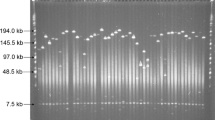Abstract
A bacterial artificial chromosome (BAC) library was constructed using nuclear DNA from pearl millet (Pennisetum glaucum), and used as a resource for the isolation of microsatellite sequences. The library contains a total of 159,100 clones with an average insert size of 90 kb, and corresponds to 5.8 haploid genome equivalents. The BAC library was pooled for screening by the polymerase chain reaction (PCR) as well as robotically gridded on high-density filters. PCR-based screening of a subset of the library (4.7 haploid genome equivalents) using five sequence-tagged site (STS) and six microsatellite markers identified between 2 and 11 positives superpools (5.4 on average). The frequency of BAC clones carrying inserts of chloroplast DNA was estimated to be less than 1% by hybridisation with a rice chloroplast probe.
Similar content being viewed by others
Author information
Authors and Affiliations
Additional information
Received: 30 January 2000 / Accepted: 16 October 2000
Rights and permissions
About this article
Cite this article
Allouis, S., Qi, X., Lindup, S. et al. Construction of a BAC library of pearl millet, Pennisetum glaucum. Theor Appl Genet 102, 1200–1205 (2001). https://doi.org/10.1007/s001220100559
Issue Date:
DOI: https://doi.org/10.1007/s001220100559




